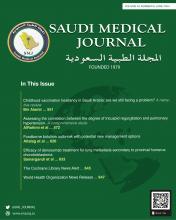Review Article
Childhood vaccination hesitancy in Saudi Arabia: are we still facing a problem? A narrative review
Bin Alamir identify the widespread and causes of vaccine hesitancy prevalance among parents of children in Saudi Arabia. A narrative review, surveying several databases. he selects studies related to vaccine hesitancy prevalence and causes after removing duplicates and screening for relevance and access to full text. A total of 18 articles meet the final selection criteria. The prevalence of parental vaccination reluctance in Saudi Arabia shown significant variability; ranging from 3.1-72.2%. Concerns regarding vaccine side effects appeared as the foremost reason for vaccine hesitancy. He concluded that numerous Saudi Arabian parents still hesitate to vaccinate their children. They believe the potential adverse effects of vaccination outweigh the protective benefits against diseases.
Flowchart of selection of articles for review.
see page 551
Original Articles
Assessing the correlation between the degree of tricuspid regurgitation and pulmonary hypertension. A comprehensive study
AlRahimi et al evaluate the relationship between severity of tricuspid regurgitation (TR) and pulmonary hypertension. A Cross-sectional study of 118 patients with pulmonary hypertension is carried out. A high proportion of patients are women (n=100, 85%) and obese (n=57, 48%). Patients with more than mild TR have higher systolic pulmonary artery pressure (sPAP) than those with trivial or mild regurgitation (p<0.001). There is a significant association between severity of TR (p<0.001) and right chambers size (p=0.001). Furthermore, pulmonary artery pressure (PAP) is significantly higher in patients with mild right ventricular impairment (p=0.001). They concluded that increase in degree of TR and right atrial size were predictors of elevated sPAP. Our findings highlight the interplay among TR, right heart size, ventricular function, and PAP. Understanding these associations can aid in risk stratification, monitoring disease progression, and potentially guiding treatment in those patients.
see page 572
Case Series
Foodborne botulism outbreak with potential new management options
Altalag et al shed some light on a potential therapeutic modality that may facilitate resolution of botulism symptoms, namely 3,4-diaminopyridine (3,4-DAP). In Riyadh, Saudi Arabia, they recently encountered a foodborne botulism outbreak that, luckily, is discovered early. In Prince Sultan Military Medical city, they admitted, during a period of approximately 3 weeks, 15 probable cases, 2 of which are excluded due to more likely alternative diagnoses. They report in this case series 13 highly suspected cases of botulism that they encountered during the outbreak. A total of 12 out of 13 patients required intensive care unit (ICU) admission, one of which required intubation. Patients showed clinical improvement when receiving botulinum antitoxin and 3,4-DAP if given early in the course of the disease. They concluded that early admisntration of 3,4-DAP may facilitate recovery and prevent disease progression. Larger prospective trials should be carried out to confirm that.
Statistics of cases in Riyadh as of May 3, 2024 as per announcement carried out by Ministry of Health on that date.
see page 626
Case Report
Efficacy of denosumab treatment for lung metastasis secondary to proximal humerus chondroblastoma
Samargandi et al report the case of a 19-year-old male patient who presented with an aggressive chondroblastoma of the proximal humerus and bilateral lung metastasis. The patient is treated with wide local resection, partial metastasectomy, and denosumab. Denosumab treatment is effective in controlling metastatic progression and preventing local recurrence. They concluded that the efficacy of denosumab treatment in controlling the progression of chondroblastoma-derived lung metastasis was clearly evident in our patient. Denosumab should, therefore, be considered for the treatment of metastatic chondroblastoma as it is safer than other previously reported treatment options. This case report confirmed the clinical efficacy of denosumab, in line with previous reports.
Chest CT reveals pulmonary metastasis before denosumab treatment.
see page 633
- Copyright: © Saudi Medical Journal
This is an Open Access journal and articles published are distributed under the terms of the Creative Commons Attribution-NonCommercial License (CC BY-NC). Readers may copy, distribute, and display the work for non-commercial purposes with the proper citation of the original work.









